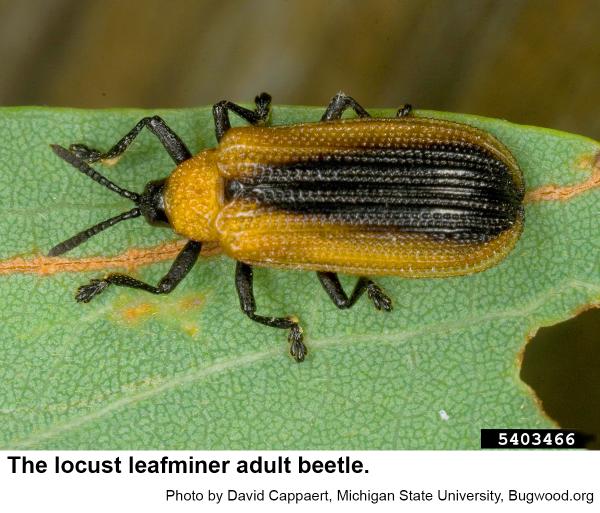CONSERVATION CORNER
A weekly blog for all things conservation
 By: Adam Chorba, Forest Specialist, Bradford County Conservation District The Black locust and Honey Locust are native, medium-sized hardwood deciduous trees with compound leaves. They are an early successional forest species, meaning that they are adapted to grow quickly in a variety of areas to aid in the natural progression of forest development. Black locust is a nitrogen-fixing legume, meaning it adds nitrogen to the soil instead of removing it and in some cases, this helps to improve soil quality. Honey locust is non-nitrogen fixing, but it develops larger and sweeter, bean like pods that are beneficial for livestock and wildlife. The wood of locust is extremely tough and rot resistant and is favored for making fence posts. They are commonly found along roadways and forest edges, often in groves. Both types of locust have a common insect that targets it that often goes unnoticed until this time of year and is often mistaken as tree blight or sudden mortality. The Locust leafminer is a small, elongated, and flatted beetle about ¼ inch long. The head is black, and the wing covers are ridged and appear orange with a broad blackish brown stripe down the center. Its larval form is a small yellowish grub that can be slightly bigger than the adult beetle. The Locust leafminers annual life cycle starts as the beetle overwinters in bark and leaflitter of locust trees and other nearby species. The beetles begin to emerge around the same time as the leaves start to develop on the locust. Upon emergence, the adult leafminer begins to feed on the outside of the leaf, mates and then lay eggs on the underside of the new leaves.
After the larvae hatch, they begin feed in a common mine or blister, feeding on the inner organic tissue between the upper and lower-leaf surface. The larvae eventually separate and begin feeding in individual mines. Each time the mine starts out very small, and gradually enlarges until most or all of the leaf is affected. The mine is transparent at first, but later turns brown as the leaf dries out. Leaves that are damaged by the locust leafminer may turn entirely brown and cling to the tree for some time, giving the tree a blighted look. This damage is most noticeable in the late summer along major roadways where it could seem like miles of trees are dying. The Locust leafminer can develop 2 generations per year, the first is in the spring, and the second begins with the appearance of adults in July. Each time the larva emerge they spread to feed on new leaves. some larger larvae will consume several different sections before maturing. With two separate generations appearing rather quickly in the same year on the same tree, combined with its feeding habits, the blight like appearance seems to show up in the stands of locust almost suddenly. Outbreaks of the locust leafminer occur regularly, but the severity of the outbreak is irregular. The irregular outbreak sizes are often attributed to several parasites and predators that can target their dense, localized population. This acts as a natural population control for the leafminer. This means that the leafminer does not maintain a large population in one area for very long. The Locust leafminer will occasionally be observed feeding on other tree species like apple, birch, beech, cherry, elm, oak, and hawthorn but not to any large concern as these are not its preferred target. The time of year when most of the damage occurs, combined with the natural ability of locust to be extremely resilient means that the locust leafminer should be noticed and monitored but not feared. The damage to the tree is often just aesthetic and well after the tree has gathered enough energy to store for regrowth during the next season so trees that are defoliated seldom die. However, if the damage occurs during a year of drought, or if the tree is stressed by other conditions, then growth loss and occasional tree mortality may occur.
0 Comments
Leave a Reply. |
AuthorsVarious staff at the Bradford County Conservation District Archives
July 2024
Categories
All
|
|
Bradford County Conservation District
Stoll Natural Resource Center 200 Lake Road, Suite E | Towanda PA 18848 Phone: (570)-485-3144 |
